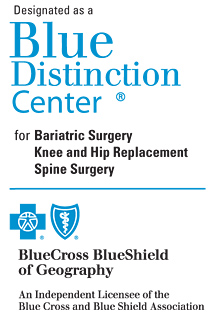Knee Replacement Options
If you have pain, stiffness or swelling caused by an injured or deteriorated knee joint, knee replacement may relieve symptoms. This procedure involves removing damaged cartilage and bone from your knee joint and substituting artificial materials, called prostheses, such as metal or plastic. Knee replacement can restore movement and relieve pain.
At El Camino Health, orthopedic surgeons perform more than 500 knee replacements each year, making us one of the leading joint replacement centers in Northern California. Our knee replacement expertise has earned recognition from nationally recognized healthcare organizations, including the Gold Seal of Approval® from The Joint Commission for hip and knee replacement and hip fracture surgery.
Treatment
At El Camino Health, our surgeons typically recommend nonsurgical options first to ease your pain, which can often provide relief. When these options are insufficient to manage your pain, your doctor may recommend surgery.
Nonsurgical Options
Depending on your level of pain and the condition of your joint, your doctor may suggest various nonsurgical options, such as:
- A cane or other assistive walking devices, or knee brace for additional support.
- Pain-managing and anti-inflammatory medications.
- Cortisone injections into your knee joint.
- Viscosupplementation injections, which lubricate your joint to make movement less painful.
- Physical therapy, exercise and conditioning.
- Limiting activities that cause pain.
- Weight loss, if you're overweight or obese.
- Dietary supplements, such as glucosamine and chondroitin sulfate.
Knee Replacement Surgery
During knee replacement surgery, your surgeon resurfaces the inside of your knee to replace damaged or worn-out cartilage.
In a healthy knee, smooth surfaces inside the knee joint allow your knee to move without pain. If your knee becomes arthritic, the surface becomes pitted and rough, making it difficult to move smoothly, resulting in pain.
To eliminate pain, your surgeon can replace damaged cartilage in your knee joint with artificial materials such as metal or plastic, which resurfaces the ends of your bones. Your new joint is attached to your thigh bone, shin and knee cap with cement or other material. When fitted together, the attached artificial parts form the whole joint. Surrounding muscles and ligaments provide support and function.
Partial Knee Replacement
Although most procedures performed at El Camino Health are total knee replacements, in some cases your doctor may recommend a partial knee replacement. During a partial knee replacement, the surgeon replaces only the most damaged part of your knee joint.
Advances in Knee Replacement Surgery
Knee replacement surgery continues to advance through improved implant materials and surgical techniques.
Mako Robotic-arm Joint Replacement
Mako Robotic Total and Partial Knee Replacement
Computer-Assisted Alignment
For knee replacements to last a lifetime, the alignment of your new joint is critical. That's why El Camino Health surgeons use advanced computer technology that offers high-definition, 3D imaging of your knee on a computer screen during surgery to ensure precise, accurate placement of the new joint.
Our team is proud to offer the latest technology in knee replacement procedures:
- Mako Robotic-Arm Assisted Total and Partial Knee Replacement. Designed for those with mid- to late-stage osteoarthritis (OA) in the knee, Mako system technology allows us to completely customize your surgical plan to fit your anatomy. To do this, we begin by taking a computerized tomography (CT) scan of your knee. Then, we upload the image to the Mako system software, which creates a 3D model of your knee. Our expert team then uses this 3D model to create your completely customized surgical plan, which allows us to create a more precise result in your knee replacement.
- ROSA Knee System. This total knee replacement technology uses information collected before and during surgery to offer your surgeon detailed insight into your unique anatomy to ensure a more precise implant placement. It begins with a series of X-rays that can be used to create a 3D model of your knee. Then during surgery, ROSA Knee functions much like a GPS system — using a camera and optical trackers to detect even the smallest movements to help your surgeon adjust accordingly.
Muscle-Sparing, Minimally Invasive Surgery
Surgeons use a minimally invasive approach that spares muscle and other tissue by using a smaller incision on the side of your knee — 3 to 5 inches instead of the 8 to 12 inches required for traditional knee replacement surgery.
A minimally invasive approach allows the surgeon to work between muscle fibers, rather than requiring an incision through a tendon. This can offer less pain, a faster recovery time and a better range of motion due to minimal scarring. Certain factors, such as your age, weight, bone size and severity of arthritis, can influence whether or not minimally invasive surgery is right for you.
Arthroscopic Knee Surgery
Surgeons can perform this minimally invasive approach by using an arthroscope — a long, thin tube with a tiny, lighted video camera — to examine the inside of your knee joint. This transmits real-time video of your joint to guide surgeons as they work, requiring only a small incision where they can manipulate specialized instruments.
Arthroscopic surgeries are used commonly to treat swelling, cartilage tears or injury, torn ligaments, and pieces of loose bone or cartilage. This surgery is typically done on an outpatient basis, requiring no overnight stay.


